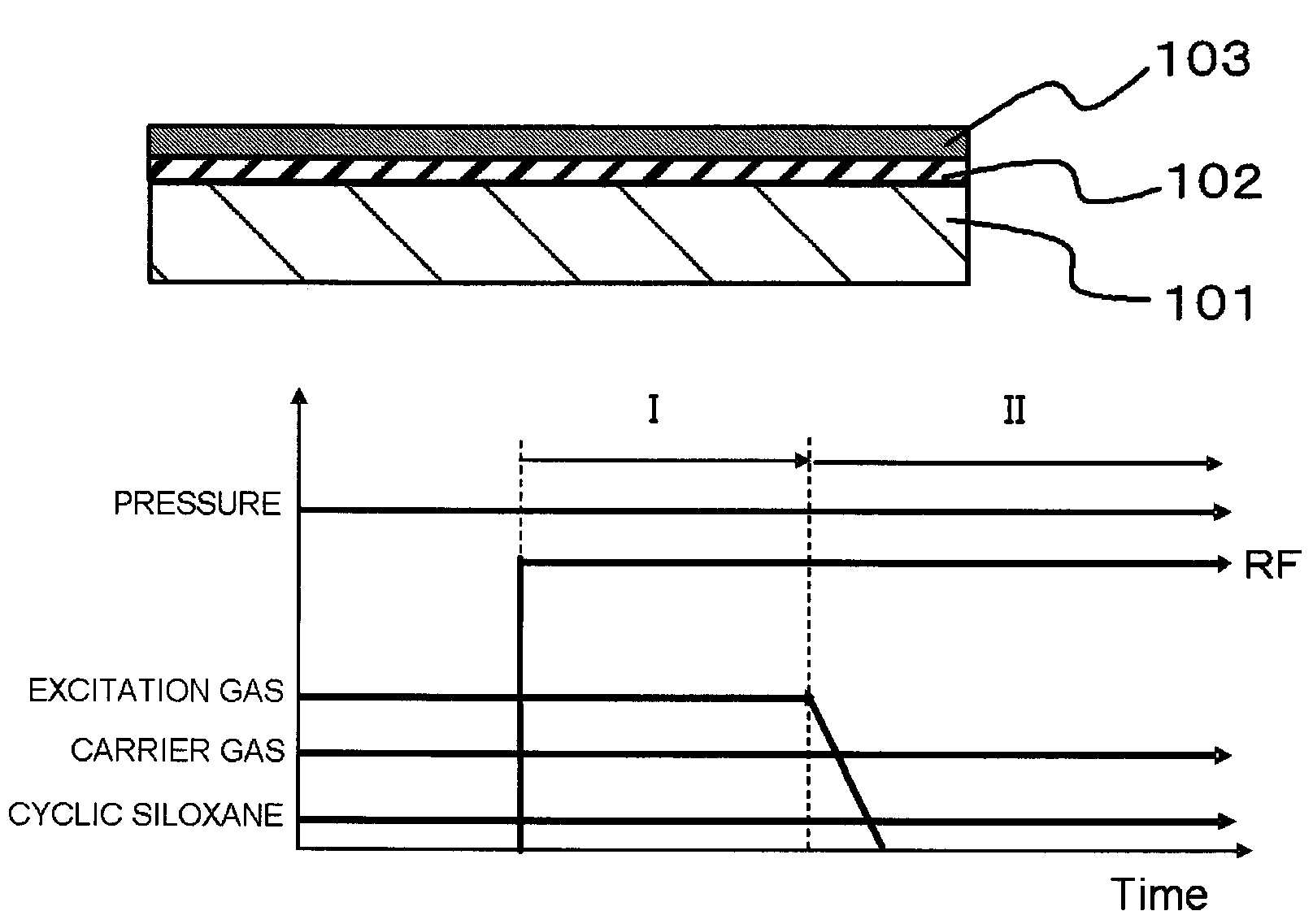Method of manufacturing semiconductor device
a manufacturing method and technology of semiconductors, applied in the direction of semiconductor devices, basic electric elements, electrical equipment, etc., can solve the problems of abnormal electrical discharge in the initial stage of film deposition, increase in power consumption, and deterioration of the thickness uniformity of the entire insulating film, so as to reduce detachment and the like, without deteriorating the reliability of the device, and achieve the effect of reducing the number of detachable parts
- Summary
- Abstract
- Description
- Claims
- Application Information
AI Technical Summary
Benefits of technology
Problems solved by technology
Method used
Image
Examples
example 1
[0107]The first insulating film 102 and the second insulating film 103 were formed according to the timing diagram of FIG. 3 using the configuration shown in FIGS. 1A to 1C. As the plasma generation apparatus, an apparatus shown in FIG. 2 was used. In the example, a silicon substrate was used as the underlying film 101 in order to perform the measurement of the film thickness uniformity more simply. Trivinyltriisopropylcyclotrisiloxane represented by the above-mentioned Formula (11) was used as the cyclic siloxane, and a He gas was used as the carrier gas. The pressure within the chamber was maintained at 280 Pa. In I region of FIG. 3, the RF power was controlled so as to have a film deposition rate of 90 nm / minute, and the first insulating film 102 was formed to have a thickness of 10 nm. At this time, in the in-plane distribution measurement of the film thickness uniformity in which a spectroscopic ellipsometer was used, the in-plane uniformity of thickness of the first insulating...
example 2
[0112]In the method of Example 1, whether the abnormal electrical discharge had arisen or not was examined by changing the thicknesses of the first insulating film 102 to be formed at 0, 3, 7, 8, 10, and 15 nm, respectively. The result is shown in Table 1.
[0113]
TABLE 1Thickness of FirstHad Abnormal ElectricalInsulating FilmDischarge Arisen?0 nmYes3 nmYes7 nmYes8 nmYes10 nm No15 nm No
[0114]When the first insulating film 102 was formed at less than 10 nm, the abnormal electrical discharge was confirmed in the initial stage of formation of the second insulating film 103. On the other hand, when the first insulating film 102 was formed to have a thickness of 10 nm and 15 nm, the abnormal electrical discharge was not confirmed throughout forming the first and second insulating films 102 and 103.
example 3
[0115]An antenna test element group (TEG) wafer was used in which a gate electrode having a pad was created on a MOS capacitor in order to measure plasma damage at the time of formation. An antenna ratio is defined as a ratio of the gate electrode area to the gate area. The wafer size is 300 mm, and the thickness of the gate insulating film is 2 nm. The first and second insulating films 102 and 103 were sequentially formed according to the timing diagram of FIG. 3 using this TEG wafer as the underlying film 101 of FIGS. 1A to 1C. Trivinyltriisopropylcyclotrisiloxane represented by the above-mentioned Formula (11) was used as the cyclic siloxane, and a helium gas was used as the carrier gas. In I region of FIG. 3, the RF power was controlled so as to have a film deposition rate of 90 nm / minute, and the first insulating film 102 having a thickness of 10 nm was formed. Thereafter, the film deposition rate was set to 120 nm / minute for ten seconds, and the second insulating film 103 havi...
PUM
 Login to View More
Login to View More Abstract
Description
Claims
Application Information
 Login to View More
Login to View More - R&D
- Intellectual Property
- Life Sciences
- Materials
- Tech Scout
- Unparalleled Data Quality
- Higher Quality Content
- 60% Fewer Hallucinations
Browse by: Latest US Patents, China's latest patents, Technical Efficacy Thesaurus, Application Domain, Technology Topic, Popular Technical Reports.
© 2025 PatSnap. All rights reserved.Legal|Privacy policy|Modern Slavery Act Transparency Statement|Sitemap|About US| Contact US: help@patsnap.com



